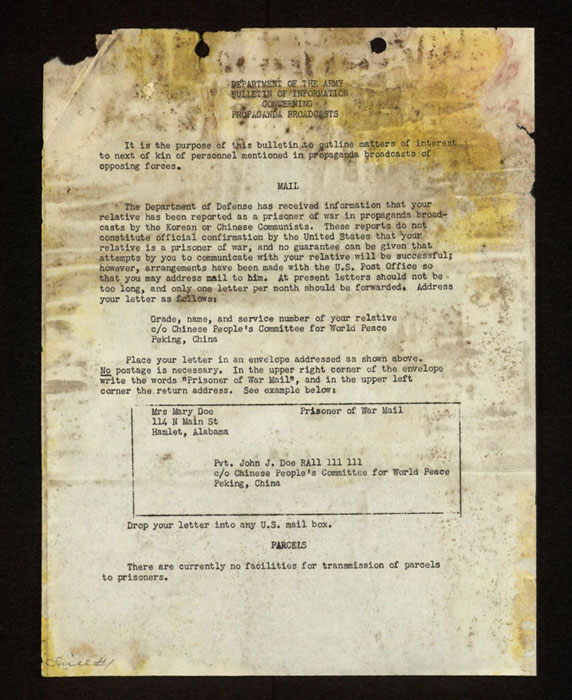Bulletin, “Department of the Army Bulletin of Information”
A bulletin produced by the U.S. Army in the early 1950s in response to “propaganda broadcasts” about Prisoners of War (POWs) being held in China and North Korea. The document explains how relatives of such POWs could attempt to send mail to prisoners held in enemy territory. The Abbott family received this bulletin because Robert Abbott had been reported as a captive by Communist forces, information that turned out to be accurate.

DEPARTMENT OF THE ARMY
BULLETIN OF INFORMATION
CONCERNING
PROPAGANDA BROADCASTS
It is the purpose of this bulletin to outline matters of interest
to next of kin of personnel mentioned in propaganda broadcasts of
opposing forces.
The Department of Defense has received information that your
relative has been reported as prisoner of war in propaganda broad-
casts by the Korean or Chinese Communists. These reports do not
constitute official confirmation by the United States that your
relative is a prisoner of war, and no guarantee can be given that
attempts by you to communicate with your relative will be successful;
however, arrangements have been made with the U.S. Post Office
so that you may address mail to him. At present letters should not be
too long, and only one letter per month should be forwarded. Address
your letter as follows:
Grade, name, and service number of your relative
c/o Chinese People’s Committee for World Peace
Peking, China
Place your letter in an envelope addressed as shown above.
No postage is necessary. In the upper right corner of the envelope
write the words “Prisoner of War Mail”, and in the upper left
corner the return address. See example below:
Mrs. Mary Doe Prisoner of War Mail
114 N Main Street
Hamlet, Alabama
Pvt. John J. Doe RA11 111 111
c/o Chinese People’s Committee for World Peace
Peking, China
Drop your letter into any U.S. mail box.
PARCELS
There are currently no facilities for transmission of parcels
to prisoners.
